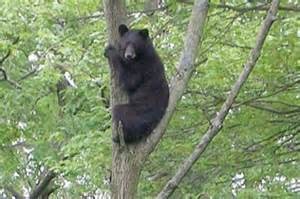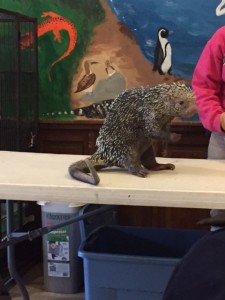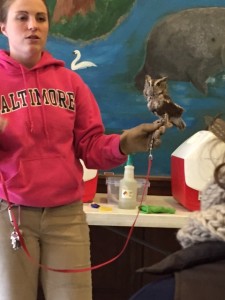Going from bird watching atop Hawk Mountain to spending time getting the Cabela’s experience was quite the adventure. These two places operate and exist based on two different interpretations of nature. Hawk Mountain appears to promote nature as something to preserve, learn about, and admire, while it would seem Cabela’s promotes nature as a form of property and a sort of prize to be had. Visiting both of these places on the same day emphasized this difference all the more and heightened how I experienced the two places as I could see one in juxtaposition to the other.
Starting our day off at Hawk Mountain, Jackie, Lori, and I spent some time walking through the museum area in the education center. Early on, while perusing the exhibit we realized that Hawk Mountain sells a version of nature that promotes the preservation, education, and admiration of nature. We learned specifically that raptors are a part of nature we should work to preserve, learn about, and admire as we walked through. First we were educated about their important roles in ecosystems, that they play a complex role and share complex inter-relationships with living things. We then learned about their history at Hawk Mountain. As mentioned in Rachel Carson’s Silent Spring in the chapter titled “And No Birds Sing” the exhibit also explained why so many raptors migrate through Hawk Mountain: the easternmost ridges of the Appalachian Mountain Range here form the last barrier to the westerly winds before dropping towards the coastal plain resulting in upward wind deflection in the autumn that provides a continuous updraft for raptors to ride without effort on their southward journeys (119). We learned that these species are worthy and in need of preservation as we were educated that raptors used to be considered vermin with a bounty on their heads and Hawk Mountain was the perfect perch for shooting them. As word of this happening became known, a woman named Rosalie Edge moved towards preserving the area and these birds by creating the Hawk Mountain Sanctuary. We also heard about a later plight calling for further preservation here from Rachel Carson in Silent Spring, that these large migration numbers passing Hawk Mountain were altered as it was observed during the days of DDT and related chemicals fewer and fewer immature eagles were migrating through signaling a reduction in reproduction (120). We then learned of Maurice Broun, the first naturalist at Hawk Mountain, who continued and expanded this desire to preserve, learn about, and admire this piece of nature. He considered this place to be a “school in the sky” and became devoted to protecting these raptors. His commitment to admiring and recording the birds contributed to the viewing and recording that still occurs atop Hawk Mountain today.
Atop the mountain, I finally had the opportunity to experience firsthand this unique phenomenon that before I had only known in an academic way. Comfortably situated among some choice rocks I was surprised to see how many raptors passed by us. After seeing the photograph of raptors lined across the ground in the education center I realized how fortunate I was to see these birds at all.
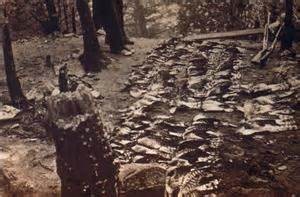
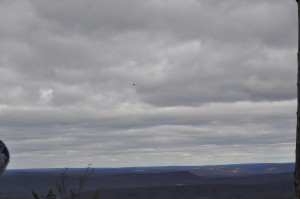
I was thrilled that there were eagles overhead, and particularly excited by the Goshawk we saw as Jeremy and I noticed on one of the tally boards on the trail only 3 have been seen this season. After learning even more about Hawk Mountain from Dr. Laurie Goodrich and spotting some birds, I began to take note of the people participating in these counts. The man next to me sat perched in the split trunk of a tree with a bleacher seating pad and a sandwich. The man in front of me had a large hiking pack and the woman beside him wore thick, insulated trousers. These people were not just here for an hour or so, they made this excursion a full day trip. As I looked over to the professional recorders I noticed how enthralled in and scrupulous they were about their counts. It was inspirational to hear these people, all so passionate about these counts, discussing sightings and teaching each other about what they had seen. I realized I had witnessed Hawk Mountain Sanctuary and the frequenters practicing stewardship of the environment, as it was clear that the protection and care of this nature was a priority to them. Not only does Hawk Mountain Sanctuary sell nature in a way that promotes the preservation, education, and admiration of nature, they sell it to and meet the demands of a culture of nature interested in the preservation, education, and admiration of nature.
Walking into Cabela’s, I was immediately overwhelmed. My eyes first darted towards the front left corner of the store where I saw a taxidermied lion on display and proceeded to trace the path of exotic animals lining the ceiling around the entire store. This path was only briefly obstructed by the mountain covered with a plethora of taxidermy in the middle of the store and the airplane hovering above. In this moment I found Cabela’s to be selling nature as a form of property or a sort of trophy to be had. Walking through the center of the store toward the mountain this notion of nature as a trophy became more apparent to me as I noticed many of the stuffed animals were marked like prizes as they were labeled by weight, year killed, and who hunted the animal. I next walked into “Deer Country” and saw replicas of record-breaking deer that had been hunted mounted on the walls.
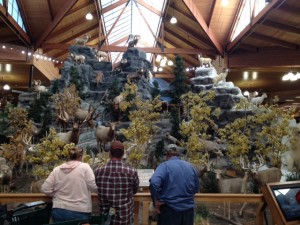
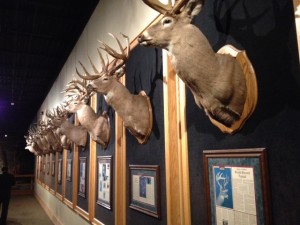
Here I saw evidence of a competing narrative for Cabela’s version of nature as I was exiting and saw a sign overhead reading, “Ensure the beauty of the outdoors-support wildlife conservation.” However, I felt as though this version of nature as something to conserve being sold was drowned by the other version of nature being sold at Cabela’s; perhaps it was drowned out even more so for me since we had just come from another place I found to be more noticeably focused on conservation. After “Deer Country” I proceeded to the large taxidermied elephant with a picture underneath displaying Dick Cabela after he had shot the elephant, and it became even clearer to me that the version of nature in this place involved the perception of nature as a prize to be had. Watching Diver Dan go straight for the largest Catfish in the tank, weighing 48 pounds, to show the crowd first this trophy of a fish, further reinforced my perception of how nature was sold in Cabela’s. Once I made it upstairs this idea of nature as property being sold by Cabela’s became evident with things such as jackrabbit mounted heads, badger pelts, and chandeliers made from antlers for sale. In addition, the sale of weapons and much of the gear stood out to me as a way to facilitate the attainment of nature as a trophy or property.
In the process of observing nature as property and a prize in this place, I found that most of the customers at Cabela’s seemed to be interested in this sort of nature as well; perhaps seeing nature as dominion. While standing at the elephant I did hear a distraught girl who was asking her friend why on Earth they would kill an elephant, however, directly next to her I saw a mother and daughter snapping a selfie with this elephant. I encountered quite a few customers taking selfies like these with some of the stuffed animals, perhaps a way of turning them into their own prize. I remember walking into “Deer Country” and passing by a “Duck Dynasty” hunting video game. I turned around to get a second look and saw two boys run toward it excitedly yelling about how it was their favorite game and they wanted to “shoot some stuff.” I also saw this interest in nature as property or a prize as I observed a group of customers participating in a gun demo in the gun section of the store where they were learning which guns best suited their purpose for attaining nature as a trophy or property. As the version of nature Hawk Mountain sold catered to one culture of nature, Cabela’s sold a version of nature that catered to another culture of nature, one more interested in nature as a prize and property.
While it may be clear from my recollection of my experiences that I identified with one of these versions and cultures of nature more than the other, I acknowledge that there are different cultures of nature and it would be difficult for one to find a sense of belonging in all of them. In the education center at Hawk Mountain Sanctuary and atop Hawk Mountain at the North lookout, I felt comfortable in the culture of nature present there. I felt as though I could spend hours identifying birds from the lookout, comfortable and content, learning how to identify them by their flight and silhouette. However, the moment I walked into Cabela’s I felt anxious and uncomfortable. While I understand this is the culture of nature for some people; it is a culture of nature to which I do not quite belong. Having these two experiences side by side was tremendously valuable and made each resonate with me strongly while facilitating my understanding of differing cultures of nature. The exhibits, sights, and interactive demonstrations I experienced at Cabela’s and Hawk Mountain Sanctuary showed they were both unique destinations. However, it is clear these two destinations cater to two different audiences, two different cultures of nature.

